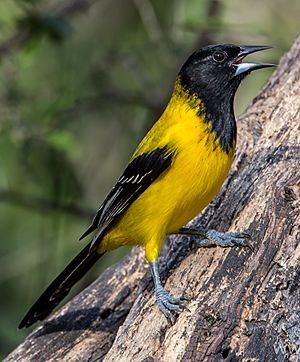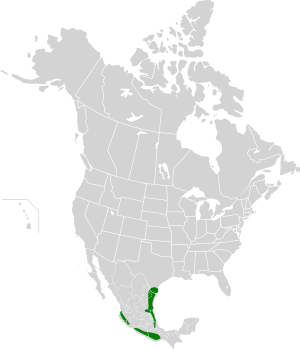Audubon's oriole facts for kids
Quick facts for kids Audubon's oriole |
|
|---|---|
 |
|
| Conservation status | |
| Scientific classification | |
 |
The Audubon's oriole (Icterus graduacauda) is a colorful bird found in forests and thickets. It lives in places like southeastern Texas and along the coast of Mexico. This bird used to be called the black-headed oriole. It's special because it's the only oriole with a black head and a bright yellow body.
There are four different types, or subspecies, of the Audubon's oriole. They live in two separate areas. One area stretches from Nayarit south to Oaxaca in western Mexico. The other area goes from the lower Rio Grande valley in Texas down to northern Querétaro in Mexico.
This oriole is a type of New World oriole. This means it's different from the "Old World orioles" found in other parts of the world. Like many birds in Central America, it doesn't migrate, meaning it stays in the same place all year. Also, male and female Audubon's orioles look very similar.
Contents
What Does It Look Like?
Male Audubon's orioles have a black head, beak, and throat. Their tail is also black. Their wings are mostly black, but the flight feathers have white edges. They have bright yellow patches on their shoulders, which look like "epaulets." Their back and underside are mostly yellow, sometimes with a bit of olive green on the back.
Female orioles look a lot like the males, but their neck and back might be a bit more olive-colored. Young orioles look similar to adults. However, their wings are a dull brown instead of black. Young birds keep a darker, greener color for a while. These birds usually shed their old feathers and grow new ones in early autumn.
Special Subspecies: dickeyae
One special type of Audubon's oriole is called I. g. dickeyae. It looks and acts a bit different from the others. This subspecies is more yellow overall because it has less of the olive-green color. Its yellow shoulder patches are also smaller. You can only find this specific subspecies in high-up pine forests in western Mexico.
How Does It Behave?
Audubon's orioles like to live in thick, evergreen forests and bushes. They especially like areas near rivers. Even though they prefer shady spots, you might sometimes see a pair looking for food in open clearings. When they fly, they often join groups of other birds, like jays and tanagers. They usually search for food hidden in thick plants.
Raising a Family
The nest of an Audubon's oriole looks like a hanging pouch or basket. It's about three inches wide and deep. The top edge of the nest is strongly woven to the tree branches. The opening is a bit narrow. They build their nests using long, green grass stems, which they weave together. They then line the inside with finer grass.
A pair of orioles usually raises two groups of babies each year. Each group, called a brood, has about three to five eggs. However, baby birds born later in the year often don't survive the winter. Sometimes, another bird called the Brown-headed cowbird will lay its eggs in the oriole's nest, and the orioles will raise the cowbird chicks.
What Does It Sound Like?
The song of the Audubon's oriole is a series of slow, smooth whistles. Its calls sound like a nasal "ike, ike, ike" or a whistled "peu."
What Does It Eat?
Audubon's orioles are clever eaters! They push their beaks into soft, dead wood or plants. Then, they use their beaks to open the plant up and find insects hiding inside. They eat insects, spiders, and fruits. They also enjoy sunflower seeds from bird feeders.
See also
 In Spanish: Turpial amarillento para niños
In Spanish: Turpial amarillento para niños


